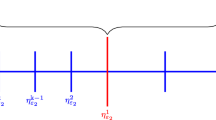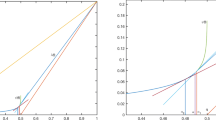Abstract
We develop mesh conditions for linear finite volume element approximations of anisotropic diffusionconvectionreaction problems to satisfy the discrete maximum principle. We obtain the sufficient conditions to gurantee the both upper and lower bounds of the numerical solution when each angle of arbitrary triangle is \(\cal{O}(\Vert q\Vert_{\infty}h+\Vert g\Vert_{\infty}h^{2})\)-acute and h is small enough, where h denotes the mesh size, q and g are coefficients of the convection and reaction terms, respectively. To deal with the convection-dominated problems, we use the upwind triangle technique. For such scheme, the mesh condition can be sharper to \(\cal{O}(\Vert g\Vert_{\infty}h^{2})\)-acute. Some numerical examples are presented to demonstrate the theoretical results.
Similar content being viewed by others
References
Bank, R.E., Rose, D.J. Some error estimates for the box method. SIAM J. Numer. Anal., 24(4): 777–787 (1987)
Bramble, J.H., Hubbard, B.E., Thomée, V. Convergence estimates for essentially positive type discrete problems. Math. Comp., 23: 695–709 (1969)
Brandts, J.H., Korotov, S., Křížek, M. The discrete maximum principle for linear simplicial finite element approximations of a reactiondiffusion problem. Linear Algebra Appl., 429(10): 2344–2357 (2008)
Burman, E., Ern, A. Discrete maximum principle for Galerkin approximations of the Laplace operator on arbitrary meshes. C. R. Math. Acad. Sci. Paris, 338(8): 641–646 (2004)
Chou, S.-H., Li, Q. Error estimates in L2, H1, L∞ in covolume methods for elliptic and parabolic problem: A unified approach. Math. Comp., 69(229): 103–120 (2000)
Ciarlet, P.G. Discrete maximum principle for finite-difference operators. Aequationes Math., 4: 338–352 (1970)
Ciarlet, P.G., Raviart, P.-A. Maximum principle and uniform convergence for the finite element method. Comput. Methods Appl. Mech. Engrg., 2: 17–31 (1973)
Ciarlet, P.G. The Finite Element Method for Elliptic Problems. North-Holland, Amsterdam, 1978
Collatz, L. Numerische Behandlung von Differentialgleichungen. Springer-Verlag, Berlin-Göttingen-Heidelberg, 1951
Crumpton, P.I., Shaw, G.J., Ware, A.F. Discretisation and multigrid solution of elliptic equations with mixed derivative terms and strongly discontinuous coefficients. J. Comput. Phys., 116: 343–358 (1995)
Ertekin, T., Abou-Kassem, J.H., King, G.R. Basic applied reservoir simulation. Richardson, Texas, 2001
Forsythe, G.E., Wasow, W.R. Finite-Difference Methods for Partial Differential Equations. John Wiley & Sons., New York, London, 1960
Gao, F., Liang, D. A new weighted upwind finite volume element method based on non-standard covolume for time-dependent convectiondiffusion problems. Internat. J. Numer. Methods Fluids, 73(11): 953–975 (2013)
Gao, Y., Liang, D., Li, Y. Optimal weighted upwind finite volume method for convectiondiffusion equations in 2D. J. Comput. Appl. Math., 359: 73–87 (2019)
Gúnter, S., Yu, Q., Kruger, J., Lackner, K. Modelling of heat transport in magnetised plasmas using non-aligned coordinates. J. Comput. Phys., 209: 354–370 (2005)
Gúnter, S., Lackner, K. A mixed implicitexplicit finite difference scheme for heat transport in magnetised plasmas. J. Comput. Phys., 228: 282–293 (2009)
Karátson, J., Korotov, S. Discrete maximum principles for finite element solutions of nonlinear elliptic problems with mixed boundary conditions. Numer. Math., 99(4): 669–698 (2005)
Karátson, J., Korotov, S., Křížek, M. On discrete maximum principles for nonlinear elliptic problems. Math. Comput. Simulation, 76: 99–108 (2007)
Li, R., Chen, Z., Wu, W. Generalized difference methods for differential equations. Numerical analysis of finite volume methods, Monographs and Textbooks in Pure and Applied Mathematics, 226, Marcel Dekker, Inc., New York, 2000
Liang, D., Zhao, W. A high-order upwind method for the convection-diffusion problem. Comput. Methods Appl. Mech. Engrg., 147: 105–115 (1997)
Liang, D., Zhao, W. An optimal weighted upwind covolume method on non-standard grids for convectiondiffusion problems in 2D. Internat. J. Numer. Methods Engrg., 67(4): 553–577 (2006)
Lin, Y., Yang, M., Zou, Q. L2 error estimates for a class of any order finite volume schemes over quarilateral meshes. SIAM J. Numer. Anal., 53(4): 2009–2029 (2015)
Liska, R., Shashkov, M. Enforcing the discrete maximum principle for linear finite element solutions of second-order elliptic problems. Commun. Comput. Phys., 3(4): 852–877 (2008)
Lu, C., Huang, Wei., Qiu, J. Maximum principle in linear finite element approximations of anisotropic diffusionconvectionreaction problems. Numer. Math., 127(3): 515–537 (2014)
Lv, J., Li, Y. L2 error estimate of the finite volume element methods on quadrilateral meshes. Adv. Comput. Math., 33(2): 129–148 (2010)
Lv, J., Li, Y. L2 error estimates and superconvergence of the finite volume element methods on quadrilateral meshes. Adv. Comput. Math., 37(3): 393–416 (2012)
Lv, J., Li, Y. Optimal biquadratic finite volume element methods on quadrilateral meshes. SIAM J. Numer. Anal., 50(5): 2379–2399 (2012)
Milne, W.E. Numerical Solution of Differential Equations. John Wiley & Sons, Chapman & Hall, London, New York, 1953
Mlacnik, M.J., Durlofsky, L.J. Unstructured grid optimization for improved monotonicity of discrete solutions of elliptic equations with highly anisotropic coefficients. J. Comput. Phys., 216: 337–361 (2006)
Neumann, M. Weakly stability for matrices. Linear Multilinear Algebra, 7(3): 257–262 (1979)
Perona, P., Malik, J. Scale-space and edge detection using anisotropic diffusion. IEEE Trans. Pattern Anal. Mach. Intell., 12(7): 629–639 (1990)
Plemmons, R.J. M-matrix characterizations. I. nonsingular M-matrices. Linear Algebra Appl., 18(2): 75–188 (1977)
Sharma, P., Hammett, G.W. Preserving monotonicity in anisotropic diffusion. J. Comput. Phys., 227: 123–142 (2007)
Stoyan, G. On maximum principles for monotone matrices. Linear Algebra Appl., 78: 147–161 (1986)
Tabata, M. A finite element approximation corresponding to the upwind differencing. Mem. Numer. Math., 4: 47–63 (1977)
Tabata, M., Fujima, S. An upwind finite element scheme for high Reynord-number flow. Internat. J. Numer. Methods Fluids, 12(4): 305–322 (1991)
Tabata, M., Fujima, S. Finite-element analysis of high Reynolds number flows past a circular cylinder. J. Comput. Appl. Math., 38: 411–424 (1991)
Terekhov, K.M., Mallison, B.T., Tchelepi, H.A. Cell-centered nonlinear finite-volume methods for the heterogeneous anisotropic diffusion problem. J. Comput. Phys., 330: 245–267 (2017)
Varga, R.S. Matrix Iterative Analysis. Prentice-Hall, Englewood Cliffs, NJ, 1962
Varga, R.S. On a discrete maximum principle. SIAM J. Numer. Anal., 3(2): 355–359 (1966)
Wang, J., Zhang, R. Maximum principle for P1-conforming finite element approximations of quasi linear second order elliptic equations. SIAM J. Numer. Anal., 50(2): 626–642 (2012)
Wang, J., Ye, X., Zhai, Q., Zhang, R. Discrete maximum principle for the P1P0 weak Galerkin finite element approximations. J. Comput. Phys., 362: 114–130 (2018)
Wang, X., Li, Y. L2 error estimates for high order finite volume methods on triangular meshes. SIAM J. Numer. Anal., 54(5): 2729–2749 (2016)
Weickert, J. Anisotropic Diffusion in Image Processing. Teubner-Verlag, Stuttgart, 1998
Xu, J., Zikatanov, L. A monotone finite element scheme for convection-diffusion equations. Math. Comp., 68(228): 1429–1446 (1999)
Zou, Q. An unconditionally stable quadratic finite volume scheme over triangular meshes for elliptic equations. J. Sci. Comput., 70(1): 112–124 (2017)
Author information
Authors and Affiliations
Corresponding author
Additional information
Conflict of Interest
The authors declare no conflict of interest.
The project is supported by the National Natural Science Foundation of China (No. 11301033, 11971069 and 12271209), the Natural Science Foundation of Jilin Province (No. 20200201259JC) and Jilin Province Science and Technology Plan Development Project (No. 20210201078GX).
Rights and permissions
About this article
Cite this article
Lin, L., Lv, Jl., Yue, Jy. et al. Mesh Conditions of the Preserving-Maximum-Principle Linear Finite Volume Element Method for Anisotropic Diffusion-Convection-Reaction Equations. Acta Math. Appl. Sin. Engl. Ser. 39, 707–732 (2023). https://doi.org/10.1007/s10255-023-1060-9
Received:
Accepted:
Published:
Issue Date:
DOI: https://doi.org/10.1007/s10255-023-1060-9
Keywords
- anisotropic diffusion-convection-reaction equation
- finite volume element method
- discrete maximum principle




